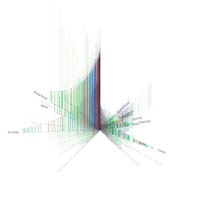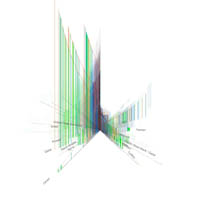The Self-Healing City / Capitalis
work-in-progress
2001 - present
One may conclude from its name that the self-healing minefield is an innovation introduced into the minefield concept for humanitarian
reasons, perhaps to automatically deactivate mines when the fighting ends. Instead the name refers to its capability to sustain its
lethality under attack- any incursion into the minefield is detected then filled by other mines that hop into the breach.
The Self-Healing City, like the minefield of the same name, repairs itself not its victims. It is the derivative of a globalization
process whose concern for self-perpetuation founds all of its manifestations. Its inhabitants are characterized by their simultaneous
lack of agency with regard to fundamental economic forces and their indispensable role as a consumer and a voter. Taking as its starting
point a built environment conceptualized as an unintegrated amalgam of economics and architecture, the Self-Healing City is an attempt to
form a method and a model for an architecture more responsive to its most formidable causes.
It is an integration whose form develops along with its means, passing through increasingly
less abstract instances of research activity that are eventually output as specific works.
Budapest Diary, The Fall of Argentina, The Accumulation Monument and Capitalis currently populate the set of works.
Capitalis is a growth map of the world economy from the years 1960 to 2001. It is interested in foregrounding the concept of growth and illuminating its
importance as a bedrock belief in our expectations of the future. With this map, growth is presented as a quality as well as a quantity, a goal that contains trade-offs
and affects that are not typically communicated or even adequately understood. The map is generated out of the orthodox economic model that has developed since
the time of the Physiocrats and Adam Smith. An important component of the model, growth theory comes with claims and predictions that from the start suggest
that economies and nations (how inseparable are the two?) are subject to long term forces. Thus, two crucial ideas advanced by growth theory, that of convergence
and diminishing returns, are conditioned by the fact that economies can be said to have a meaningful temporal trajectory.
Convergence says that poorer countries will eventually catch up to richer countries in terms of their wealth per person ratios. The length of time required for this to
happen is an unknown, and it is also agreed that whether convergence happens at all depends on a countryís particular political and cultural environment, in
addition to its endowment of natural resources.
Diminishing returns refers to the slow down in growth that happens after a country has reached a certain level of wealth. Poor countries as they develop increase
their output compared to their input ratios, as they get richer this ratio begins to decrease. This phenomenon must logically occur for convergence to happen.
However, it is a fate countries seek to avoid if they want to continue to increase their living standards, and the theory includes an important modification, that of
technological innovation, that can exempt a country from the law of diminishing returns and set it on a course of perpetual growth.
Capitalis takes GDP per capita data researched and compiled by Angus Maddison and published by the OECD from the years 1960-2001 then develops a mapping
technique that charts the progress of growth and convergence. The result of this effort is not only a map, but also a mode of inquiry that could extend the scope
of the mapís initial premises. The idea, for instance, that a country after a certain point of its development is subject to a law of diminishing returns significantly
conditions the action taken by a country with regard to its economic structure. The idea also suggests that a specific action may have different effects according
to what stage of growth a country is in.
As a countryís growth begins to slowdown, choices have to be made as to how to improve their input to output ratio. The problem is how to hold down costs
while at the same time maintaining the aggregate demand required to make the economy run without inflation or a recession. Holding down costs includes technological
improvements in the production process, trading for goods that are made more cheaply by another country, and holding down the cost of labor, either by squeezing wages
or outsourcing to another country. The danger in squeezing wages is that it can lead to an aggregate weakening of demand since the consumer is taking home comparatively
less pay. This is an outline of the wage/profit tradeoff. Similarly, outsourcing displaces some jobs for others, also weakening aggregate demand by further decreasing the
value of the worker. Inter-temporal trade, i.e. debt, can shore up demand by putting money in place now that has to be returned later with interest. Innovations
in the production process however increase output without affecting the other factors of production, namely labor, and would seem that this is the only hope out of the problem of a
growth slowdown without having to necessarily involve squeezing wages and incorporating debt.
Developing proper conditions for growth introduces the problem of implementation. Incentives given to the factor of production dealing with technological innovation could
act as a catalyst, and harnessing the forces of competition between capitalists could lead to the accustomed improvement of living standards enjoyed by wealthy countries.
This argument dissuades government intervention other than enabling the natural behavior of companies, which is to cut costs, innovate and expand. Aggregate demand
is the beneficiary of these incentives applied to the supply side of the economy as innovation creates job opportunities and products that were either stagnant or did not even
exist before.
Social costs are deflated in the preceding argument. Companies acting naturally may lead to irreversible job losses, disappearing communities, concentrations of wealth
and a rise in equality, an overall retreat in the aggregate quality of life regarded as an end to which economic means must be qualified by. A counter-argument calls on
government to correct undesirable outcomes and to flatten the playing field of competition, either through improving education, regulation of untoward business practices,
redistribution of wealth through taxation, and eliminating uneconomic barriers to upward mobility.
On the right side of the political spectrum, proponents of the first argument blame uneconomic intervention by government as the problem, then proceed to advocate surgery
that runs the risk of killing the patient. The counter-argument from the center-left usually ends up promising both economic growth AND protection against the social costs that result from
the very actions taken to foster growth. This best of both worlds argument would only be true if there were enough of growth in the first place not to place it in a trade-off
with social costs.
So, it turns out that it is the rich countries with the problem after all. It is the slowdown in growth which leads to the search for profits that sends companies looking elsewhere
for both labor markets and markets for their goods. It is the slowdown in growth that leads to trade-offs between wages and profits, pro-growth policies and public goods normally
associated with prosperity. It is the consumers and producers of the rich countries that have the market power to move the energy and resources of the world. It is the rich
countries that provide the model for generating wealth that are being replicated by developing countries.
It may come as no surprise that the most successful countries at generating wealth are also the most democratic. It follows that democracy is quite expensive, and that if there is
not enough growth to go around, or not enough natural resources or affordable labor inputs to feed it, democracy itself may be compromised- democracies
defend their wealth just like anybody else. Convergence is then of more than academic interest if democracy is inextricably linked to wealth, and wealth is linked to the actions
between and within states to maximize it.
Growth depends not only on innovation and new products but also on markets. Combating diminishing returns compels humans to continue to increase their capacity to consume,
and the carrying capacity of the earth to provide the energy and absorb the waste of this consumption. It should also come as no surprise that not only are the richest countries the
most democratic, they also produce the most waste. The growth of waste follows the growth of wealth, and as long as the two parallel each other, it is hard to wish away escalating
environmental costs that come with accumulation.
In sum, Capitalis is an effort to understand the world as a limit condition for economics rather than the other way around. The conquest of nature and the
yoking of future resources towards present day needs has paradoxically led to scorn for the physical resistance of the earth and the
body, the unconstructable endowments that need no justification and which form the fundament for economic motion in the first place.















